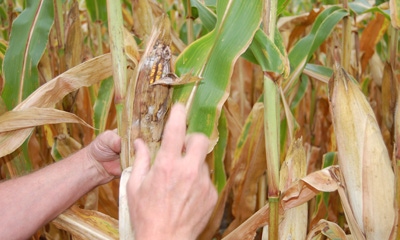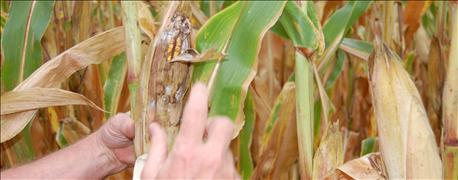
The Crop Watch ’16 field is planted to GMO corn. That may minimize potential insect problems that impact stalks and ears, but it doesn’t necessarily eliminate them. It partially depends on which insects the trait or traits in the corn control. Some traits don’t control all possible insects that could infest corn at this time of year.

WATCH FOR INSECTS: This nasty scene developed after western bean cutworm invaded ears, opening them up to disease and sprouting from water intake into the ear.
Here are three insects you may want to watch for in your fields at this point in the season. Some are more likely to occur in certain regions or on certain soil types than in other locations. To get an idea for what’s happening in your area, you can follow weekly catches of moths for insects such as western bean cutworm and fall armyworm in the Purdue University Pest & Crop Newsletter, issued online weekly by the Purdue Extension Entomology Team.
1. western bean cutworm
Counts were relatively high for this insect in most of northwestern and parts of north-central Indiana. There are traits that control western bean cutworm, but some breakdown in at least one of the older traits was reported in 2015.
According to the Purdue University Corn and Soybean Field Guide, western bean cutworm larvae are grayish-brown to pinkish-tan with longitudinal stripes. Damage can occur until harvest. What makes this insect so devastating is that three to four larvae may feed on one ear, boring holes and opening up the ear to diseases and sprouting.

WESTERN BEAN CUTWORM: Western bean cutworm invades corn ears before harvest. Often, three or more larvae gang up on the same ear. Note the hole in the husk and ear where the insect bored through.
2. fall armyworm
These smooth-skinned caterpillars can vary from light-green to tan to nearly black. Both whorl and ear-feeding can occur, typically on later-maturing corn. Whorl damage may resemble hail damage in corn. According to the Purdue guide, treatment may be necessary if 75% of the plants show whorl feeding, plants are stressed and larvae are less than 1.25 inches long.

FALL ARMYWORM: This insect can cause damage in corn all the way to harvest in some situations. (Photo courtesy of John Obermeyer, Purdue University entomologist)
3. corn borer
Shot-hole damage on older leaves caused by the first generation may still be visible. The Purdue guide notes that the second generation typically burrows into stalks and even into ear shanks. In severe cases, ear dropping may occur, causing yield loss. Most traited corn controls corn borer, but if you grow non-GMO corn, you may want to stay alert to signs of corn borer infestation.

CORN BORER: This non-GMO corn is infested with corn borer. Note the hole at the base of the ear on the upper left side of the photo.
About the Author(s)
You May Also Like




